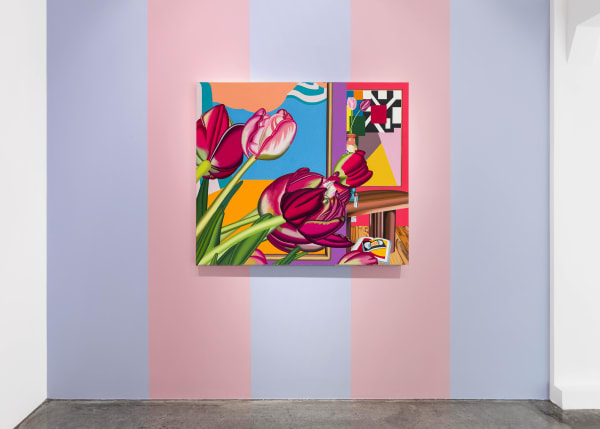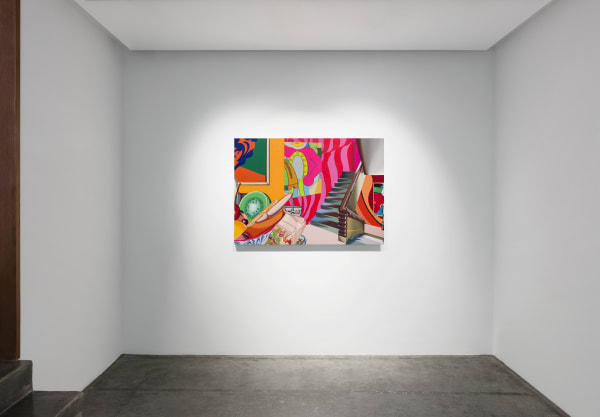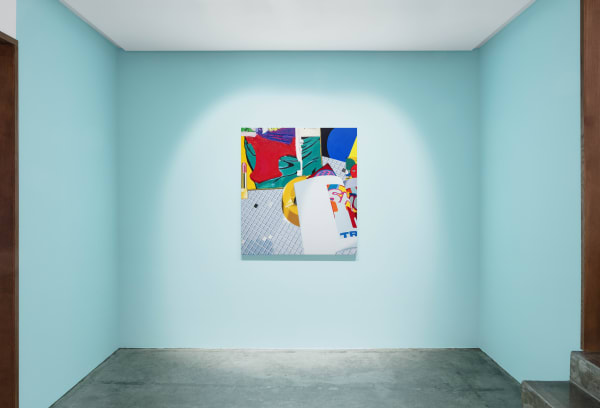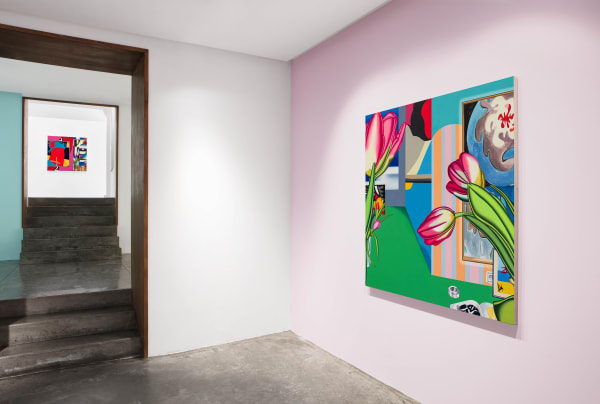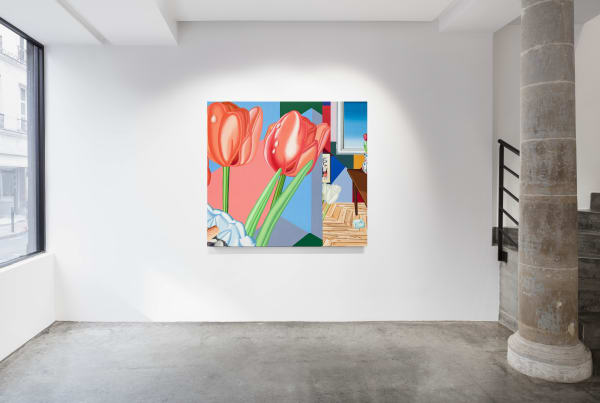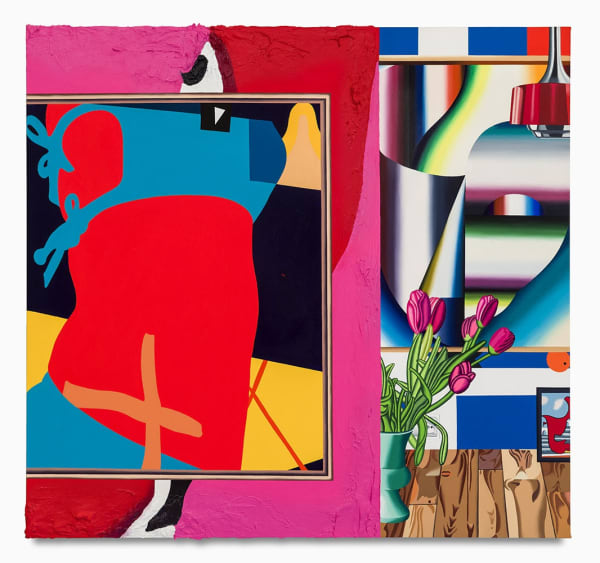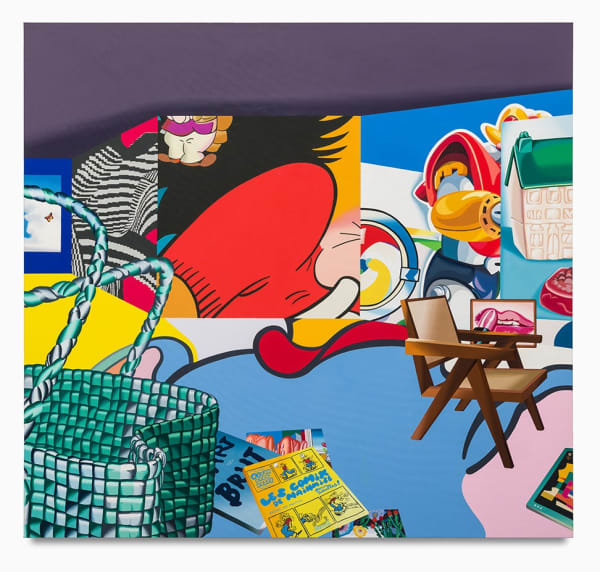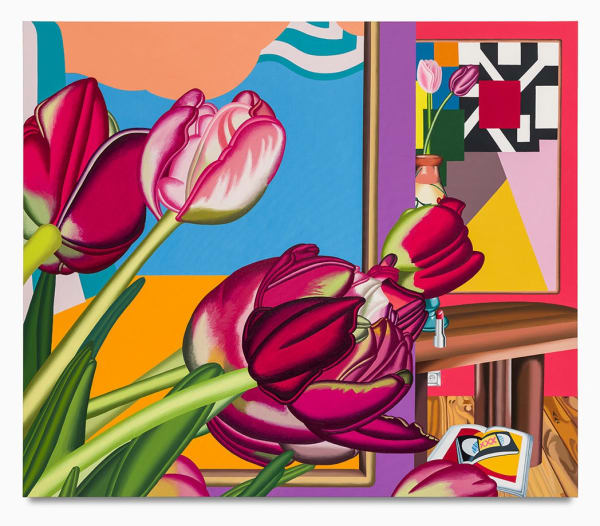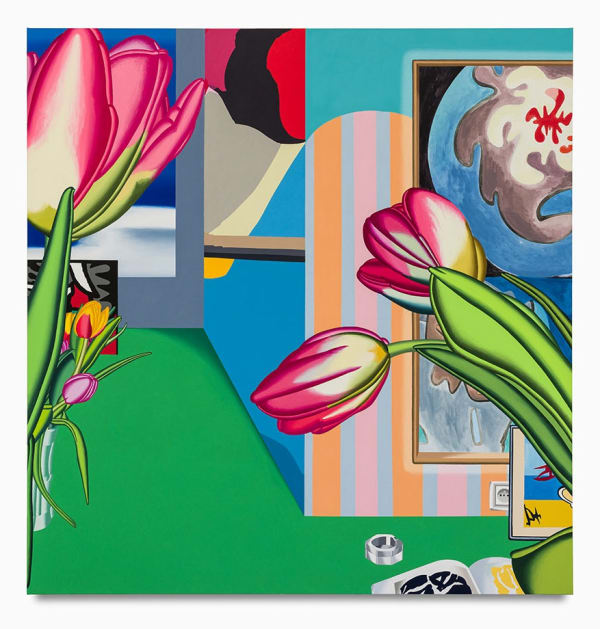Louis Granet presents a new solo exhibition: Comme chez toi! at Zidoun-Bossuyt Paris.
Comme chez toi ! brings together a series of paintings featuring interiors.
But not just any interiors: those of art collectors.
These opulent spaces are characterised by picture rails, large volumes, their wide walls, as well as their vases and bouquets, their handbags, their paintings by modern and contemporary masters adorning the same wide walls.
Such canonical subject, spacing from history of artistic commissions to interiors sheltered from the hecticness of the world may seem distant to most.
Yet something lies under the surface. Or rather on it.
In these unstable perspectives of accumulated objects telling stories of impressive spaces, the canvases of Comme chez toi ! , while they represent interiors, they are perhaps also a sort of self-portraiture. Self-portraits of the artist at work, lonely, glimpsing at the opulence of the spaces he stumbles into.
But not just any interiors: those of art collectors.
These opulent spaces are characterised by picture rails, large volumes, their wide walls, as well as their vases and bouquets, their handbags, their paintings by modern and contemporary masters adorning the same wide walls.
Such canonical subject, spacing from history of artistic commissions to interiors sheltered from the hecticness of the world may seem distant to most.
Yet something lies under the surface. Or rather on it.
In these unstable perspectives of accumulated objects telling stories of impressive spaces, the canvases of Comme chez toi ! , while they represent interiors, they are perhaps also a sort of self-portraiture. Self-portraits of the artist at work, lonely, glimpsing at the opulence of the spaces he stumbles into.
As a painter, Louis Granet exhibits in galleries and sells his paintings to collectors : it’s his job.
Collectors’ apartments are to him a workspace. The workspace where Louis meets those who allow him to live of his practice and where hangs his paintings.
It is therefore a space of projections, where he questions the proximity that he builds between this universe and his own aspirations, through his practice.
Collectors’ apartments are to him a workspace. The workspace where Louis meets those who allow him to live of his practice and where hangs his paintings.
It is therefore a space of projections, where he questions the proximity that he builds between this universe and his own aspirations, through his practice.
Comme chez toi ! thus operates on a double level of interpretation.
His paintings can be seen as the continuity of a commissioned art – which gives a referential field as a legitimate playground. Such legitimacy is also given by the use, for the first time in his work, of oil painting, conferring historicity as well as depth of field.
They can also be the tale of a generation that can no longer distinguish the subject of a work from the context it is produced in: a peculiar word, and therefore the testimony of a momentaneous condition of the artist.
It may be at this stage, in the practice of Louis Granet, that a parallel to the 1960s debate opposing pop art to narrative figuration may arise: can we represent reality by disregarding what is unfair, without aiming to indignation?
His paintings can be seen as the continuity of a commissioned art – which gives a referential field as a legitimate playground. Such legitimacy is also given by the use, for the first time in his work, of oil painting, conferring historicity as well as depth of field.
They can also be the tale of a generation that can no longer distinguish the subject of a work from the context it is produced in: a peculiar word, and therefore the testimony of a momentaneous condition of the artist.
It may be at this stage, in the practice of Louis Granet, that a parallel to the 1960s debate opposing pop art to narrative figuration may arise: can we represent reality by disregarding what is unfair, without aiming to indignation?
It appears to me that Louis Granet, rather than opposing those two points of view, seeks to make them co-exist.
He belongs to a generation that refuses to consider creation as a mere demiurgic act, that producing artworks can no longer be a blank space to be filled with indifference, that nowadays we say art workers and not just Artist, with an indulgent capital letter.
Behind these canvases, in the middle of the opulence of these large walls, between these bouquets and these handbags, we see Louis: alone, full of his convictions that he perhaps shares, by this necessity to take a stance, as much as the honesty of embracing the fascination exerted by the beauty and the comfort of these spaces as potential rewards of a practice carried out in his atelier.
The transparency of such ambivalence is justified, within each of the artworks that make part of this series, by the presence of clear references to the painters who accompanied the practice of Louis Granet. Artworks of Shirley Jaffre, Hervé Télémaque, Ida Ekblad, among others, line the walls of these fantasized apartments, to the point of determining the very core of the painted scene. They are as much statutory objects, symbols of exclusivity, as tutelary figures to which Louis Granet pays homage. Such profusion testifies to the devotion of the artist to his own practice as well as what he owes to it. These references also translate the influence of abstraction, a genre to which many of them relate, in the work of Louis Granet.
Isn’t it visible elsewhere, in this series with a figurative appearance?
Perhaps in the very operation of these tableaus. Fantasies as much as landscapes, representations as much as mental spaces, they testify to the possibility for painting to make perceptible, through abstraction, “the invisible life that we are”.
Isn’t it visible elsewhere, in this series with a figurative appearance?
Perhaps in the very operation of these tableaus. Fantasies as much as landscapes, representations as much as mental spaces, they testify to the possibility for painting to make perceptible, through abstraction, “the invisible life that we are”.
The collector’s apartment, with its large volumes and its wide walls, its vases and its master paintings, has become a space for confession, a gradual reveal.
Text written by Samuel Belfond, independent author and art critic
2023年5月31日
